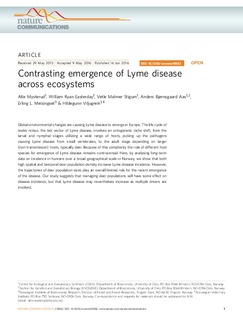| dc.contributor.author | Mysterud, Atle | |
| dc.contributor.author | Easterday, William Ryan | |
| dc.contributor.author | Stigum, Vetle Malmer | |
| dc.contributor.author | Aas, Anders Bjørnsgard | |
| dc.contributor.author | Meisingset, Erling L. | |
| dc.contributor.author | Viljugrein, Hildegunn | |
| dc.date.accessioned | 2016-07-21T08:46:23Z | |
| dc.date.accessioned | 2018-05-29T10:56:06Z | |
| dc.date.available | 2016-07-21T08:46:23Z | |
| dc.date.available | 2018-05-29T10:56:06Z | |
| dc.date.issued | 2016 | |
| dc.identifier.citation | Mysterud, A., Easterday, W. R., Stigum, V. M., Aas, A. B., Meisingset, E. L., & Viljugrein, H. (2016). Contrasting emergence of Lyme disease across ecosystems. Nature communications, 7, 11882. | nb_NO |
| dc.identifier.issn | 2041-1723 | |
| dc.identifier.uri | http://hdl.handle.net/11250/2499563 | |
| dc.description.abstract | Global environmental changes are causing Lyme disease to emerge in Europe. The life cycle of Ixodes ricinus, the tick vector of Lyme disease, involves an ontogenetic niche shift, from the larval and nymphal stages utilizing a wide range of hosts, picking up the pathogens causing Lyme disease from small vertebrates, to the adult stage depending on larger (non-transmission) hosts, typically deer. Because of this complexity the role of different host species for emergence of Lyme disease remains controversial. Here, by analysing long-term data on incidence in humans over a broad geographical scale in Norway, we show that both high spatial and temporal deer population density increase Lyme disease incidence. However, the trajectories of deer population sizes play an overall limited role for the recent emergence of the disease. Our study suggests that managing deer populations will have some effect on disease incidence, but that Lyme disease may nevertheless increase as multiple drivers are involved. | nb_NO |
| dc.language.iso | eng | nb_NO |
| dc.rights | Navngivelse 4.0 Internasjonal | * |
| dc.rights.uri | http://creativecommons.org/licenses/by/4.0/deed.no | * |
| dc.subject | Bacterial infection | nb_NO |
| dc.subject | Ecological epidemiology | nb_NO |
| dc.title | Contrasting emergence of Lyme disease across ecosystems | nb_NO |
| dc.type | Journal article | nb_NO |
| dc.type | Peer reviewed | nb_NO |
| dc.date.updated | 2016-07-21T08:46:23Z | |
| dc.description.version | publishedVersion | nb_NO |
| dc.rights.holder | This work is licensed under a Creative Commons Attribution 4.0 International License. The images or other third party material in this article are included in the article’s Creative Commons license, unless indicated otherwise in the credit line; if the material is not included under the Creative Commons license, users will need to obtain permission from the license holder to reproduce the material. To view a copy of this license, visit http://creativecommons.org/licenses/by/4.0/ | nb_NO |
| dc.source.pagenumber | 11 | nb_NO |
| dc.source.volume | 7 | nb_NO |
| dc.source.journal | Nature Communications | nb_NO |
| dc.identifier.doi | 10.1038/ncomms11882 | |
| dc.identifier.cristin | 1368753 | |

